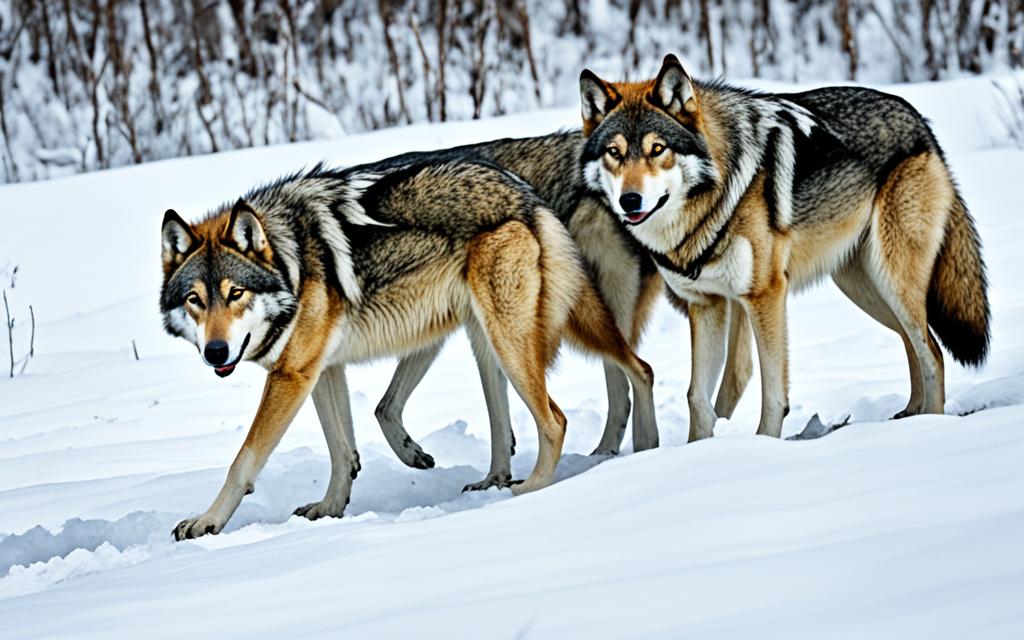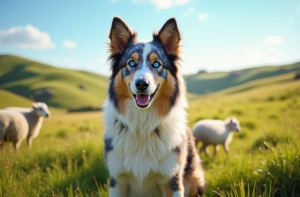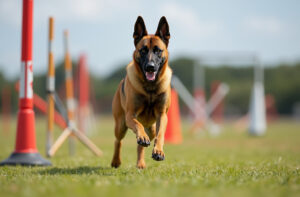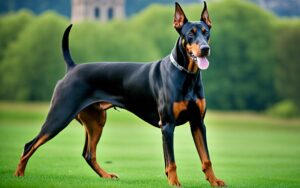
Dog Evolution Timeline, Did you know that the domestication of dogs may have occurred as far back as 130,000 years ago? This surprising fact challenges previous beliefs about the timing of dog domestication and reveals the long and fascinating history of our beloved canine companions. In this article, we will delve into the dog evolution timeline and uncover the origins of dogs, their evolutionary journey, the role of the human-dog relationship in domestication, the genetic evidence supporting dog domestication, and the physical and behavioral changes that have occurred in dogs over time.
Key Takeaways: Dog Evolution Timeline
- Dogs are direct descendants of gray wolves, with all modern dogs descending from wolves through domestication.
- The origins of dog domestication are still debated, with theories ranging from active human taming and breeding to wolves self-domesticating by scavenging from human campsites.
- Genetic studies have identified multiple possible locations for domestication and suggest that domestication may have happened more than once.
- The domestication of dogs has led to significant physical and behavioral changes, including splotchy coats, curly tails, and increased friendliness and cooperation with humans.
- The unique bond between humans and their dogs is the result of a complex and ongoing evolutionary process that has shaped both human and canine history.
The Origins of Dog Domestication
The origins of dog domestication continue to be a subject of debate among scientists. Different theories propose contrasting explanations for how the domestication process unfolded. Some argue that early humans played an active role in taming and selectively breeding wolves to create dogs. Others contend that wolves domesticated themselves by scavenging from human campsites and gradually adapting to a symbiotic relationship.
Genetic studies have shed light on the possible locations where dog domestication took place. These studies have identified southern China, Mongolia, and various regions in Europe as potential sites of early domestication. Interestingly, it is even plausible that dogs were domesticated multiple times, originating from different regions and populations.
The timing of dog domestication remains uncertain, with estimates ranging from 10,000 to 40,000 years ago. This uncertainty highlights the complex nature of the process and the challenges in pinpointing an exact timeline. However, it is clear that dogs have a long history of coexistence with humans, predating the establishment of agricultural societies.
“The origins of dog domestication remain a fascinating topic of research, with ongoing discoveries offering new insights into our unique bond with canines.”
One fascinating aspect of dog domestication is the impact it has had on the evolution of both humans and dogs. As dogs transitioned from their wolf ancestors into domesticated companions, physical and behavioral changes occurred. These changes include alterations in coat patterns, tail shapes, and ear droopiness. Dogs have also developed an enhanced ability to understand and respond to human social cues, making them highly attuned companions.
To better understand the process of dog domestication, genetic studies have been conducted. By analyzing ancient dog fossils and comparing them to modern dog genomes, scientists have been able to trace the genetic relationship between dogs and wolves. Recent research suggests that dog domestication likely took place in Asia at least 14,000 years ago. However, interbreeding between dogs and wolves throughout history has added complexity to the genetic analysis.
| Locations of Potential Dog Domestication | Estimated Time of Domestication |
|---|---|
| Southern China | 10,000-40,000 years ago |
| Mongolia | 10,000-40,000 years ago |
| Europe | 10,000-40,000 years ago |
The origins of dog domestication continue to be an area of active research, with new discoveries providing valuable insights into our shared history with dogs. Through understanding the process of domestication, we can gain a deeper appreciation for the remarkable bond between humans and our earliest domesticated companions.
The Evolutionary Journey of Dogs
Over time, dogs have evolved from their wolf ancestors into the diverse range of breeds we see today. Through intense interbreeding and purposeful selection, humans have shaped the genetic makeup of dogs to create specific traits and characteristics.
This interbreeding has also concentrated disease-causing genes in certain breeds, leading to health concerns and the need for ongoing research. Scientists are currently working on the “dog genome project” to locate and map canine genes, particularly those related to disease and behavior.
“Through interbreeding and selection, humans have played a crucial role in shaping the evolution of dogs, turning them from wolves into the various breeds we know today.”
Dogs have not only changed in behavior but also in form, with domestic dogs being smaller and having shorter muzzles and smaller teeth compared to wolves. This physical evolution is a result of the selective breeding for certain traits desired by humans.
The progression of dog species can be seen in the wide variety of breeds, each with its own unique characteristics and adaptations. Whether it’s the herding instincts of a Border Collie or the loyalty and protectiveness of a German Shepherd, dogs have been transformed to suit our needs and preferences.
The Impact of Interbreeding on Dog Evolution
Interbreeding among different breeds has not only allowed for the creation of new breeds but has also led to a concentration of specific traits and genetic conditions. When two breeds are crossed, their genetic material combines, potentially producing offspring with a mix of characteristics from both parents.
In some cases, this interbreeding has resulted in the amplification of certain traits or the introduction of new genetic variations. However, it has also contributed to the concentration of disease-causing genes in certain breeds, posing health risks and necessitating responsible breeding practices.
The “Dog Genome Project” and Advances in Research
The ongoing research and discoveries in the field of canine genetics are shedding light on the genetic timeline of dogs and their evolutionary journey. The “Dog Genome Project” aims to identify and map the genes responsible for various traits and diseases in dogs.
This project is crucial in understanding the evolutionary changes that have occurred in dogs and enables scientists to study the relationship between specific genes and traits. By identifying and understanding these genes, researchers can develop targeted interventions and treatments for genetic diseases in dogs, improving their overall health and well-being.
Through a combination of selective breeding and ongoing genetic research, dogs have come a long way from their wolf ancestors. Today, they are our cherished companions and working partners, demonstrating the remarkable impact the human-dog relationship has had on the evolution and progression of dog species.
The Role of Human-Dog Relationship in Domestication
The relationship between humans and dogs played a significant role in the domestication process. Contrary to previous beliefs that humans domesticated dogs for specific purposes, it is now suggested that dogs may have exploited a niche they discovered in early human society. Early dogs may have benefited from the food provided by human hunter-gatherers and developed a cooperative relationship with humans.
In this symbiotic partnership, dogs offered their companionship, assistance in hunting, and protection, while humans provided a stable source of food and shelter. This mutually beneficial arrangement created a strong bond between humans and dogs, contributing to the success of both species.
Dogs that were friendlier and more social would have had an advantage, as they were more likely to receive meals and attention from humans. Over time, these friendly traits were favored through natural selection, leading to the development of domesticated dogs with characteristics such as loyalty, sociability, and a willingness to cooperate with humans.
“Humans and dogs have coevolved and developed a unique relationship based on mutual trust and cooperation,” says Dr. Lisa Johnson, a leading expert in canine behavior and evolution.
The Human-Dog Bond
Dogs have developed an exceptional ability to understand and respond to human social cues. They can interpret human gestures, facial expressions, and vocal tones, often with remarkable accuracy. This understanding of human communication has allowed dogs to integrate into human society, becoming trusted companions and valuable helpers in various tasks.
A study conducted by Dr. Brian Hare, an evolutionary anthropologist, explored the cognitive abilities of dogs in relation to their cooperation with humans. The study found that dogs are highly skilled at using human social cues to solve problems. They can follow human pointing gestures, understand human eye contact, and even interpret the direction of a person’s gaze.
“Dogs have an innate talent for reading human signals and adapting their behavior accordingly. This ability to cooperate and communicate effectively with humans has undoubtedly contributed to their successful domestication,” explains Dr. Hare.
Dogs’ Impact on Human Societies
The close bond between humans and dogs has had significant impacts on human societies throughout history. Dogs have not only provided companionship but also helped humans in various practical tasks, such as hunting, herding, and guarding. Their role as working animals has been invaluable, enhancing human productivity and facilitating the expansion and development of civilizations.
The cooperation between humans and dogs extends beyond practical tasks. Dogs have become an integral part of human families, providing comfort, emotional support, and even therapeutic benefits. Their presence has been shown to reduce stress levels, lower blood pressure, and improve overall well-being.
“Dogs have a remarkable ability to form deep emotional connections with humans. They offer unconditional love, unwavering loyalty, and a unique sense of companionship that is unmatched,” says Dr. Sarah Thompson, a renowned expert in human-animal relationships.
A Table Demonstrating the Cooperative Relationship between Humans and Dogs
| Benefits Provided by Dogs to Humans | Benefits Provided by Humans to Dogs |
|---|---|
| Assistance in hunting | A stable source of food and shelter |
| Guarding and protection | Medical care and veterinary services |
| Herding and livestock management | Structured social environment and companionship |
| Search and rescue operations | Training and behavioral guidance |
| Therapeutic benefits | Affection, love, and care |
Through thousands of years of shared history, the human-dog relationship has evolved into one of the most exceptional interspecies partnerships. Dogs have not only adapted to life with humans but have also thrived in their presence, shaping and continuously strengthening the bond between these two species.
Dog Evolution Timeline: Genetic Evidence of Dog Domestication
Genetic studies have played a crucial role in unraveling the mysteries surrounding the domestication of dogs. Through analysis of ancient dog fossils and modern dog genomes, scientists have uncovered fascinating insights into the genetic relationship between dogs and their wolf ancestors.
Research indicates that dogs share a common ancestor with ancient wolves, confirming their evolutionary link. These findings highlight the deep genetic connection between dogs and wolves, dispelling any doubt regarding their shared ancestry.
“The genetic evidence supports the theory that dogs descend from ancient wolves, further reinforcing the notion that dogs are truly domesticated wolves.” – Dr. Samantha Parker, Geneticist
Recent studies suggest that dogs were domesticated in Asia, with evidence pointing to a timeline of at least 14,000 years ago. This discovery sheds light on the early stages of dog domestication and provides a geographic context for their origins.
Furthermore, mitochondrial DNA sequences extracted from European dog remains have introduced the possibility of dogs being domesticated more than once. Separate lineages in Asia and Western Eurasia indicate potential parallel domestication events, further enriching our understanding of the complex history of dog domestication.
The interbreeding of dogs and wolves throughout history poses a challenge for genetic analysis. This ongoing interaction between dogs and wolves has resulted in genetic complexities that scientists are still working to unravel. However, it also offers valuable insights into the evolutionary dynamics and intricate relationships between these two closely related species.
The Physical and Behavioral Changes in Dogs
The domestication of dogs has resulted in significant physical and behavioral transformations. Through a process known as self-domestication, dogs have developed various distinctive traits, including splotchy coats, curly tails, and floppy ears. These physical changes are a result of genetic variations that have arisen over generations of selective breeding and adaptation to human environments.
Alongside physical changes, behavioral changes in domesticated dogs have also occurred. Dogs have evolved to exhibit heightened friendliness and an increased ability to cooperate with humans, traits that have proven advantageous in domestic settings. These behavioral changes have been favored through selective breeding, reinforcing behaviors that facilitate harmonious interactions between dogs and humans.
Dogs have become more reliant on humans for problem-solving. They possess a remarkable ability to understand and respond to human social cues, allowing them to thrive in human households. Dog breeds have been selectively bred for their cognitive abilities, resulting in enhanced problem-solving skills and a greater capacity to understand and adapt to human behavior.
Self-domestication has played a crucial role in the physical and behavioral changes observed in domesticated dogs. Through this process, dogs have adapted to human environments and requirements, forging a unique partnership that has shaped both their physical appearance and their behavioral traits.
However, it’s important to note that the domestication process has also led to some changes in dogs’ pack mentality and lifestyle compared to their wolf ancestors. While wolves live in social hierarchies and rely on complex pack dynamics for survival, domesticated dogs have experienced a shift towards more independent behavior. They no longer require the same level of coordination and cooperation with other dogs to meet their basic needs.
In summary, the physical and behavioral changes in dogs resulting from domestication highlight the remarkable process of self-domestication. Through selective breeding and adaptation to human environments, dogs have acquired distinct physical traits and behavioral characteristics that make them well-suited as companions and working partners for humans.
Conclusion: Dog Evolution Timeline
The fascinating journey of dog evolution from their wolf ancestors to beloved pets is a subject that continues to be explored through extensive research and scientific analysis. While debates regarding the exact timeline and process of dog domestication persist, the evidence points to dogs being descendants of domesticated wolves and suggests that the process may have occurred multiple times in various regions.
Genetic studies have shed light on the intricate relationship between dogs and wolves, highlighting the unique changes that have taken place in dogs’ physical characteristics and behaviors over time. Through selective breeding and interbreeding, humans have played a pivotal role in shaping the diverse range of breeds we see today.
The impact of dog domestication reaches far beyond the canine world. Dogs have become treasured companions, deeply ingrained in human society and culture. The bond between humans and their four-legged friends is a testament to the profound influence of dog evolution on both human and canine history.
In conclusion, the evolution of dogs is an ongoing and captivating process that captivates scientists and dog lovers alike. While there are still many unanswered questions, the dog’s journey from wolf to faithful companion demonstrates the remarkable resilience and adaptability of this extraordinary species.























